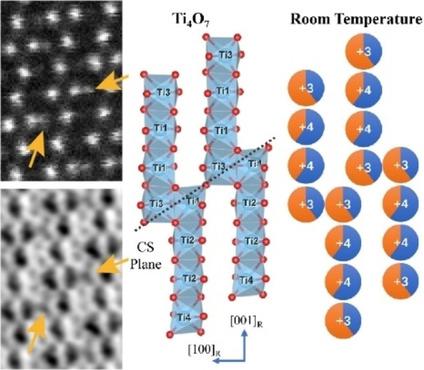当前位置:
X-MOL 学术
›
Z. Anorg. Allg. Chem.
›
论文详情
Our official English website, www.x-mol.net, welcomes your
feedback! (Note: you will need to create a separate account there.)
Andersson‐Magnéli Phases TinO2n‐1: Recent Progress Inspired by Swedish Scientists
Zeitschrift für anorganische und allgemeine Chemie ( IF 1.1 ) Pub Date : 2020-12-25 , DOI: 10.1002/zaac.202000408 Qing Zhang 1 , Weiyan Liu 2 , Yi Zhou 2 , Junyan Li 2 , Tu Sun 2 , Qingyuan Liu 3 , Yanhang Ma 4 , Jinghui Wang 4 , Jun Li 2 , Ruoshi Zhao 5 , Yu Sui 6 , Takashi Matsumoto 7 , Norihiro Muroyama 7 , Akihito Yamano 7 , Kenneth D. M. Harris 8 , Zhijian James Shen 5 , Osamu Terasaki 2
Zeitschrift für anorganische und allgemeine Chemie ( IF 1.1 ) Pub Date : 2020-12-25 , DOI: 10.1002/zaac.202000408 Qing Zhang 1 , Weiyan Liu 2 , Yi Zhou 2 , Junyan Li 2 , Tu Sun 2 , Qingyuan Liu 3 , Yanhang Ma 4 , Jinghui Wang 4 , Jun Li 2 , Ruoshi Zhao 5 , Yu Sui 6 , Takashi Matsumoto 7 , Norihiro Muroyama 7 , Akihito Yamano 7 , Kenneth D. M. Harris 8 , Zhijian James Shen 5 , Osamu Terasaki 2
Affiliation

|
Among homologous series of metal oxides, Andersson‐Magnéli phases TinO2n‐1 (n=4–10) have attracted renewed scientific attention because of their behaviour in electrical conductivity and chemical/thermal stability. Various applications have also been reported for the phases with different values of n, or slightly reduced rutile (TiO2). The characteristic properties of these materials depend strongly on the compositional deviation from TiO2 and the way in which the structure accommodates the deviation. Thus, an urgent requirement is to overcome difficulties in characterizing such materials at atomic resolution. Here, we trace the discovery of the Andersson‐Magnéli phases, and report the application of recent developments in electron microscopy to reveal the relation, at the local level, between structural characteristics and electronic states, specifically for the materials TinO2n‐1 with n=4–8. The electrical conductivity of Ti4O7 has been reported previously to show three clearly distinct states on decreasing temperature from 300 K. For this reason, we focus on Ti4O7 as a representative example of the TinO2n‐1 phases and report structural characteristics at temperatures corresponding to each of the three different phases, focusing on the distribution of Ti3+ and Ti4+ cations from analysis of single‐crystal XRD data. Electron diffraction experiments and electrical conductivity measurements are also reported.
中文翻译:

Andersson-Magnéli阶段的TinO2n-1:瑞典科学家的最新进展
在金属氧化物的同源系列中,Andersson-Magnéli相Ti n O 2n-1(n = 4-10)由于其在电导率和化学/热稳定性方面的表现而引起了新的科学关注。对于具有不同n值或金红石(TiO 2)含量略有降低的相,也已报道了各种应用。这些材料的特性很大程度上取决于与TiO 2的成分偏差以及结构适应偏差的方式。因此,迫切需要克服以原子分辨率表征这些材料的困难。在这里,我们追踪了安德森-马格尼利相的发现,并报告了电子显微镜的最新进展的应用,以揭示在局部水平上结构特征与电子态之间的关系,特别是材料Ti n O 2n-1与ñ = 4-8。以前已经报道过Ti 4 O 7的电导率在温度从300 K降低时显示出三个明显不同的状态。因此,我们集中于Ti 4 O 7作为Ti n O 2n-1相的代表例子,并报告了在对应于三个不同相的温度下的结构特征,重点是通过分析单晶XRD数据得出的Ti 3+和Ti 4+阳离子的分布。还报道了电子衍射实验和电导率测量。
更新日期:2021-02-11
中文翻译:

Andersson-Magnéli阶段的TinO2n-1:瑞典科学家的最新进展
在金属氧化物的同源系列中,Andersson-Magnéli相Ti n O 2n-1(n = 4-10)由于其在电导率和化学/热稳定性方面的表现而引起了新的科学关注。对于具有不同n值或金红石(TiO 2)含量略有降低的相,也已报道了各种应用。这些材料的特性很大程度上取决于与TiO 2的成分偏差以及结构适应偏差的方式。因此,迫切需要克服以原子分辨率表征这些材料的困难。在这里,我们追踪了安德森-马格尼利相的发现,并报告了电子显微镜的最新进展的应用,以揭示在局部水平上结构特征与电子态之间的关系,特别是材料Ti n O 2n-1与ñ = 4-8。以前已经报道过Ti 4 O 7的电导率在温度从300 K降低时显示出三个明显不同的状态。因此,我们集中于Ti 4 O 7作为Ti n O 2n-1相的代表例子,并报告了在对应于三个不同相的温度下的结构特征,重点是通过分析单晶XRD数据得出的Ti 3+和Ti 4+阳离子的分布。还报道了电子衍射实验和电导率测量。











































 京公网安备 11010802027423号
京公网安备 11010802027423号